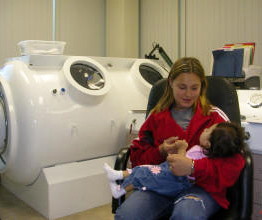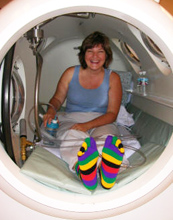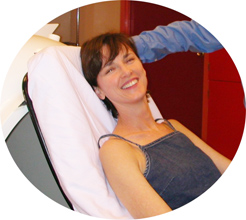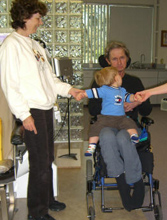Patients investigating HBOT are often facing chronic medical problems and have exhausted established medical treatment options. Health decisions are much too important to be made without the advice of a Doctor or other health care practitioner. We invite and encourage you to share this information with your doctor.
Our Centers provide their physicians with an opportunity to prescribe HBOT for “unapproved” health conditions and have HBOT administered in a professional environment. Our consulting and referring physicians use clear guidelines for specific conditions.
Be informed and then make the right decisions for your health
The information presented here is for informational purposes only and is not intended to substitute for the advice of a physician.
Because the FDA views oxygen-under-pressure as a drug, a prescription from a registered Medical Doctor (M.D.), Doctor of Osteopathy (D.O.) or Doctor of Dental Surgery (D.D.S.) is mandatory for all patients.
The chambers used by our Centers have an FDA 510K clearance number and are cleared for use in the treatment of only thirteen life and limb salvage indications as listed by the Undersea and Hyperbaric Medical Society (UHMS.) However, HBOT has a much larger list of applications, some of which are documented by stronger scientific evidence than exists for the accepted UHMS indications. These other applications are considered “off-label” uses of hyperbaric oxygen therapy by the FDA.
A licensed physician can use best-care medical judgment and is lawfully allowed to prescribe HBOT for illnesses other than the “approved” UHMS indications.
Over the last ten years, physicians have sent their patients to our clinics, choosing to add HBOT as an off -label strategy to support their conventional medical treatments. In most instances, the improvement in patient’s quality of life was impressive. However, because the conditions listed below are off-label, by law no claims can be made regarding the efficacy of HBOT in the treatment of these illnesses.
• Autism
• Bed Sores (decubitus ulcers)
• Cerebral Edema: toxic encephalopathy (exposure to toxic chemicals, mold and other infections)
• Cerebral Palsy
• Chronic Fatigue Syndrome
• Closed head injury
• Concussion – post concussive syndrome
• Cranial nerve syndromes – neuralgia
• Dental implant enhanced healing
• Diabetic limb salvage
• Enhanced healing of broken bones
• HIV and AIDS related neuropathies
• Lyme Disease
• Migraine and vascular cluster headaches
• Multiple Sclerosis
• Spinal cord contusion
• Sporting injuries – bruising and muscle damage, tendon and ligament damage
• Stroke
• Traumatic injuries
• Vegetative coma
Bell’s Palsy
Bell’s palsy is a common affliction characterized by the fairly sudden onset of weakness of one side of the face. Typically, patients are offered steroids early in the course of their illness in hopes of reducing swelling of the nerve involved in facial movement. Exciting new research demonstrates that hyperbaric oxygen therapy is significantly more effective than steroids in the treatment of Bell’s palsy – both shortening the length of illness as well as increasing the likelihood of full recovery.
Cerebral Palsy
Cerebral Palsy (CP) is characterized by a lack of physical coordination, involuntary movement, and often retarded or slowed neuronal development. Often there is a combination of challenges, including a degree of autism.
Scientific studies are just beginning for HBOT treatment of CP, but the anecdotal evidence is overwhelming. One of the primary causes of CP is poor oxygenation of the developing brain, which HBOT excels in treating. Our own patients have shown dramatic improvement in all areas of their disability. The greatest improvements have been seen in young children, as their brains are still developing.
Lyme Disease
Lyme Disease, first discovered in 1975, is an infectious illness transmitted by ticks. In the past decade, Lyme Disease has spread across the nation and has increased in incidence some ten fold. Lyme infection may produce muscle and joint pain, immune system dysfunction, nervous system abnormalities, cardiac problems, and fever.
Typically, if aggressive antibiotic therapy is initiated early in the course of the illness, successful treatment is achieved. Unfortunately, many patients do not adequately respond to antibiotic therapy and essentially become incapacitated by this illness.
New and exciting research showing the efficacy of hyperbaric oxygen therapy now offers hope to patients crippled by chronic Lyme disease. These improvements include pain reduction, return of clarity of mentation, reduction of depression, and frequently the ability to discontinue antibiotics.
Meniere’s Disease
Patients diagnosed with Meniere’s disease typically suffer from recurrent attacks of disabling vertigo with progressive hearing loss. Until recently, therapeutic options were limited to either aggressive surgical or medical approaches.
Research published in a recent issue of Audiology confirms usefulness of HBO in Meniere’s disease. HBO treated patients experienced significant improvement in attacks of vertigo as well as hearing. These improvements continued when these patients were re-evaluated two years after the hyperbaric oxygen treatment program.
Migraine Headaches
Hyperbaric oxygen therapy is an extremely useful modality in the abortive management of migraine headache. Research at the University of Pittsburgh published in the journal Headache found that 90% of migraine patients experienced virtually complete relief of pain when treated acutely with HBO.
Multiple Sclerosis
Over the past two decades, extensive international medical research has demonstrated that HBO can play an extremely important role in the treatment of Multiple Sclerosis (MS). In many European countries, HBO is now considered an integral part of the MS treatment program – in England alone, over 10,000 MS patients are currently receiving hyperbaric oxygen treatment.
In a recent publication in the prestigious New England Journal of Medicine entitled, “Hyperbaric Oxygen Treatment of Multiple Sclerosis, a Randomized, Placebo Controlled, Double-blind Study,” researchers demonstrated significant objective improvements in a variety of MS symptoms in 70% of patients treated. At one year after treatment, deterioration was noted in 55% of MS patients not treated as compared to only 12% of patients who underwent hyperbaric oxygen treatment.
Barnes and co-workers publishing in the Journal of Neurology, Neurosurgery, and Psychiatry, demonstrated a remarkable slowing of cerebellar function (coordination) deterioration in their report of 120 MS patients one year following hyperbaric oxygen treatment. Other studies have shown an improvement in bladder function in HBO treated MS patients.
Hyperbaric oxygen therapy is a potent therapeutic modality for the successful treatment of multiple sclerosis without the potential side effects associated with many currently used medications.
Reflex Sympathetic Dystrophy
Although uncommon, reflex sympathetic dystrophy can be a crippling disease characterized by swelling and severe pain of an extremity, at times following what would otherwise have been trivial trauma. Treatment options including injection techniques and medication have met with only limited success. Having demonstrated its usefulness in clinical studies, HBO offers an effective treatment option in treating reflex sympathetic dystrophy.
Stroke
It has been estimated that at the present time there are about 1.7 million stroke survivors in this country and each year 700,000 Americans suffer the serious sequels to stroke.
Regrettably, a commonly held belief is that once an area of the brain has been damaged by a stroke, nothing can be done to restore the function of that area. Recent scientific research has revealed that while the more central areas of stroke involve brain tissue may be irreversibly damaged, there exists an area surrounding this tissue which may be functionally salvaged with the use of hyperbaric oxygen.
Since the early 1970’s, scientific journals have reported over 1,000 cases demonstrating a 40-100% rate of improvement for stroke patients treated with HBO. In the journal Stroke, Dr. Richard Neubauer, a pioneer in the use of hyperbaric oxygen and various neurological diseases, reported outstanding results in a group of 122 stoke patients treated with HBO. In one case, significant functional improvement was noted when HBO therapy was given 14 years after the initial stroke event.
The benefit of hyperbaric oxygen in stroke patients likely results from its ability to enhance the metabolism of so-called “idling nerve cells” as well as increasing oxygen supply surrounding the area of maximal damage. Nuclear imaging has shown that oxygen embarrassed areas of the brain actually grow new blood vessels in the process known as angiogenesis.
One of the hottest areas in medicine is on the plasticity of the adult brain.
This understanding has benchmarked from the works of Dr. Michael Merzenich, Professor of Neuroscience at the University of California, San Francisco and Dr. Jeffrey Schwartz, Professor of Neuroscience at University of California, Los Angeles.
Through research and case studies, these medical scientists have demonstrated the brain’s ability to be drastically rewired, not just in childhood but throughout life – a paradigm-shifting discovery that could transform the treatment of every neurological dysfunction, from dyslexia to stroke.
Clinical observation of stroke patients treated at this clinic in the last decade bear witness to the accuracy of this new science of neuroplasticity. When HBOT is added to other stroke rehabilitation as recommended by Merzenich and Schwartz, patients have a better chance of resuming the lives they led before their stroke.
Toxic Brain Injury (Encephalopathy)
Many ingested substances (e.g. chemical, such as solvents and other commonly used household substances) or infections (e.g. Lyme Disease, mold) can cause what was once though to be permanent brain damage characterized by short-term memory loss, depression, anxiety and diminished mental functioning.
The damage can be extreme, to the point of the patient becoming comatose or in a “rag-doll” coma or “locked-in” state. Our clinic has treated numerous patients under the care and guidance of their physicians, and we have observed normal brain functions return.
Wound Healing
Without question, one of the most widely recognized applications of hyperbaric oxygen has been in the area of wound healing. Over the past 30 years, hundreds of scientific articles have been published describing profound enhancement in healing of a variety of problematic wounds with hyperbaric oxygen therapy. These conditions include decubitous ulcers, venous stasis ulcers, arterial insufficiency ulcers, burns, crush injuries, severed limbs, non-healing bone fractures, diabetic foot ulcers, brown recluse spider bites, poorly healing skin grafts, and osteoradionecrosis (bone damage as a result of excessive radiation exposure). The mechanisms by which HBO enhances healing include:
• Hyperoxygenation – increase tissue levels of oxygen
• Neovascularization – enhance growth of new blood vessels
• Antimicrobial effect – destroys harmful bacteria
• Leukocyte activation – enhances ability of white blood cell to remove bacteria and debris
• Fibrolastic proliferation – increases growth of cells which form reparative tissue.
Hyperbaric oxygen therapy can be an important adjunct in a comprehensive wound healing program utilized in conjunction with other modalities including surgical, medical, and physiotherapeutic techniques.




